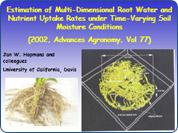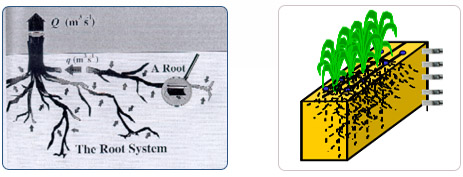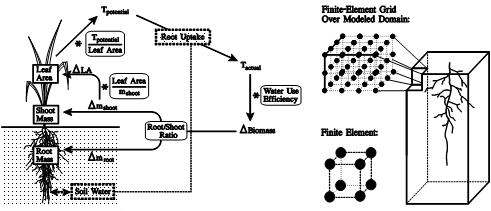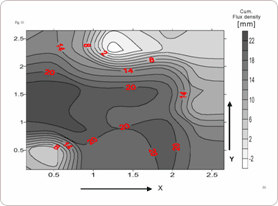 |
Download: Presentation |
The importance of root function in water and nutrient transport is becoming increasingly clear, as constraints on agricultural resources are imposed due to water limitations and environmental concerns. Both are driven by the increasing need to expand the global food production. However, the historical neglect of consideration of water and nutrient uptake processes below ground has created a knowledge gap concerning the plant responses of nutrient and water limitations to crop production. We have developed models that simulate water uptake, and nutrient uptake, simultaneously with water and nutrient transport in a multi-dimensional modeling framework. It is recommended that water and nutrient transport and uptake be coupled, including salinity effects on root water uptake and the provision of simultaneous passive and active nutrient uptake. We emphasize the need for multi-dimensional dedicated root water and nutrient uptake experiments to validate and calibrate hypothesized coupled root uptake models.

A. Transient root growth modeling
B. Rootwater uptake estimation in the field
____________________________________________________________
A. Transient root growth modeling

The model that has been developed includes formulation of interactions
between plant growth and nutrient concentration, thus providing a tool
for studying the dynamic relationships between changing soil-water, nutrient
status, temperature, and root activity. The model presented offers the
most comprehensive approach to date in the modeling of the dynamic relationship
between root architecture and the soil domain.
The convection-dispersion equation used for the simulation of nutrient
transport was considered in its comprehensive form, thus allowing a realistic
description of solute fate in the soil domain. Soil-water uptake was computed
as a function of matric and osmotic potential, whereas absorption of nutrients
by the roots was calculated as a result of passive and active uptake mechanisms.
Uptake and respiration activities varied along the root axis and among
roots as a result of root age. Genotype-specific and environment-dependent
root growth processes such as soil moisture, nutrient concentration and
soil temperature, were included using empirical functions. In concept,
the modeling approach followed the requirement that plant transpiration
and assimilation are directly coupled through the water use efficiency
term. The root and soil parameters of root length, surface area, age,
soil water content, temperature, and nutrient concentration are computed
within priori-selected volume elements at any desired temporal resolution.
Root water and nutrient uptake was computed at the same time and space
scales, and were dynamically controlled by root and soil parameters in
both unstressed and stressed conditions (soil resistance, temperature,
water and nutrient stress).
In order to solve the flow and transport equations, the soil domain was discretisized into a rectangular grid of finite elements. Root growth, architecture, and age is simulated starting from a germinating seed that ‘grows’ at user-defined time intervals with new segments added to the apex of each growing root. The flow and transport model was integrated with the root growth model, allowing soil-plant root interactions through water and nutrient uptake as a function of root properties (size and age) and soil properties (water content and nutrient concentration). Moreover, soil water content, resistance, nutrient concentration, and temperature affected root growth and architecture directly. The model tracks each segment by recording its topological position within the root system, and its spatial location within the model domain, as well as its age, mass and surface area.
The three-dimensional root growth and flow model is available upon request: jwhopmans@ucdavis.edu
References:
Somma, F., V. Clausnitzer, and J.W. Hopmans. 1998. Modeling of transient three-dimensional soil water and solute transport with root growth and water and nutrient uptake. Plant and Soil. 202:281-293. DOWNLOAD: PDF
Somma, F., V. Clausnitzer and J.W. Hopmans. 1997. An algorithm for three-dimensional, simultaneous modeling of root growth, transient soil water flow, and solute transport and uptake. Version 2.1. LAWR Report 100034. DOWNLOAD: PDF
Clausnitzer, V. and J. W. Hopmans. 1994. Transient three-dimensional modeling of soil water flow and root growth. Plant and Soil 164(2):299-314.
Teruel, D.A., D. Dourado-Neto, J.W. Hopmans, and K. Reichardt. 2001. Structural changes in soybean root system as a response to soil phosphorus availability. Scientia Agricola. Vol. 58:5-60 (In Portuguese). DOWNLOAD: PDF
Teruel, D.A., D. Dourado-Neto, J.W. Hopmans, and K. Reichardt. 2000. Mathematical modeling as a tool for the analysis of growth and architecture of root systems. Scientia Agricola. Vol. 57:683-691 (In Portuguese). DOWNLOAD: PDF
B . Root water uptake estimation

A multi-dimensional approach in root water uptake is needed if uptake is varying in space thereby allowing a more accurate quantification of spatial variability of the soil water regime, including water flux densities below the rooting zone.
Corresponding root water uptake parameters were obtained from inverse modeling , minimizing the residuals of measured and simulated water content values around the almond tree. Simulated water content values were obtained using the transient three-dimensional HYDRUS-3D model, from which drainage fluxes below the rooting zone were computed.
The effect of multi-dimensional root water uptake in an otherwise uniform soil can be illustrated by considering the resulting spatial variation in drainage flux. For example, the Figure below shows a detailed two-dimensional contour plot of the spatial variability of cumulative flux density (mm) during the monitoring period.

Evidently, spatial variability of the drainage rate is large, with values increasing as corresponding root water uptake values decrease. Also, variability analysis showed that the spatial variation in drainage rate and root water uptake decreased significantly when simplifying multi-dimensional soil water flow and root water uptake to decreasing spatial dimensions. The increasing accurate spatial description of root water uptake and soil water flow with increasing spatial dimension is essential to improve model predictions of water fluxes and contaminant transport through the vadose zone. Moreover, total chemical load to the groundwater will depend on local concentration and fluxes, and their spatial variability. Specifically, the actual chemical load can be much larger than the average chemical load, when computed from average flux and concentration values using strictly one-dimensional simulations.
References
Vrugt, J.A., M.T. van Wijk, J.W. Hopmans, and J. Simunek. 2001. One, two, and three- dimensional root water uptake functions for transient modeling. Water Resour. Res. 37:2457-2470. Link to : DOWNLOAD: PDF
Hopmans, J.W., and K.L. Bristow. 2001. Current capabilities and future needs of root water and nutrient uptake modeling. Advances in Agronomy. Volume 77: 104-175, 2002. DOWNLOAD: PDF
Vrugt, J.A., J.W. Hopmans and J. Simunek. 2001. Calibration of a two-dimensional root water uptake. Soil Sci. Soc. Amer. J. 65:1027-1037. DOWNLOAD: PDF
Hopmans, J. W. and E. Guttierez-Rave. 1988. Calibration of a root water
uptake model in spatially variable soils. Journal of Hydrology 103:53-65.
DOWNLOAD:
PDF